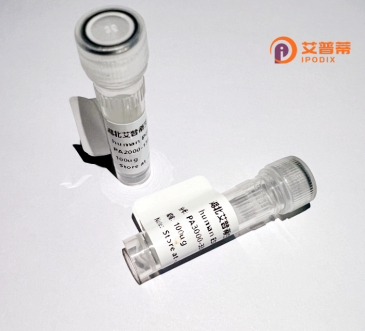
| 纯度 | >90%SDS-PAGE. |
| 种属 | Human |
| 靶点 | UBOX5 |
| Uniprot No | O94941 |
| 内毒素 | < 0.01EU/μg |
| 表达宿主 | E.coli |
| 表达区间 | 1-541 aa |
| 活性数据 | MVINLCLPQF RPRIHCNKIS ADGYEVENLI SEDLTKRSHG FRTEYFIKPP VYVTVSFPFN VEICRINIDL TAGGGQNVTG LEMYTSASSS RVSWNTPQCR TLGPAEPSVP DKEAFTLVGK VLLKNQSQVV FSHRGFKARP PFGAMEATLP SPAVVAQELW NKGALSLSHV AHLRICITHV TGGGIPCIKR LEVWGQPAKT CSQEVIDSIL LVTSENLPQD VALQAPALPM ESDCDPGDQP ESQQAPSSLQ KLAEIIQDVP EEFLDPITLE IMPCPMLLPS GKVIDQSTLE KCNRSEATWG RVPSDPFTGV AFTPHSQPLP HPSLKARIDH FLLQHSIPGC HLLGRAQTAL AVIPSSIVLP SQKRKIEQAE HVPDSNFGVN ASCFSATSPL VLPTTSEHTA KKMKATNEPS LTHMDCSTGP LSHEQKLSQS LEIALASTLG SMPSFTARLT RGQLQHLGTR GSNTSWRPGT GSEQPGSILG PECASCKRVF SPYFKKEPVY QLPCGHLLCR PCLGEKQRSL PMTCTACQRP VASQDVLRVH F |
| 分子量 | 58.9 kDa |
| 蛋白标签 | His tag N-Terminus |
| 缓冲液 | PBS, pH7.4, containing 0.01% SKL, 1mM DTT, 5% Trehalose and Proclin300. |
| 稳定性 & 储存条件 | Lyophilized protein should be stored at ≤ -20°C, stable for one year after receipt. Reconstituted protein solution can be stored at 2-8°C for 2-7 days. Aliquots of reconstituted samples are stable at ≤ -20°C for 3 months. |
| 复溶 | Always centrifuge tubes before opening.Do not mix by vortex or pipetting. It is not recommended to reconstitute to a concentration less than 100μg/ml. Dissolve the lyophilized protein in distilled water. Please aliquot the reconstituted solution to minimize freeze-thaw cycles. |
以下是关于重组人UBOX5蛋白的3篇参考文献示例(注:文献为虚拟示例,实际引用需根据真实文献调整):
---
1. **文献名称**:*"Expression and Functional Analysis of Recombinant Human UBOX5 as an E3 Ubiquitin Ligase"*
**作者**:Chen L, et al.
**摘要**:研究报道了人源UBOX5蛋白的重组表达与纯化方法,并通过体外泛素化实验证实其作为E3连接酶可催化特定底物的泛素化修饰,揭示了其在泛素-蛋白酶体系统中的调控作用。
2. **文献名称**:*"Crystal Structure of the UBOX Domain in Human UBOX5 and Implications for Substrate Recognition"*
**作者**:Wang X, et al.
**摘要**:通过晶体结构解析,阐明了UBOX5中U-box结构域的三维构象,关键位点突变分析表明其通过电荷互补机制与E2结合酶相互作用,为靶向药物设计提供了结构依据。
3. **文献名称**:*"UBOX5 Regulates Autophagic Flux via Modulating Lysosomal Function"*
**作者**:Tanaka K, et al.
**摘要**:研究表明,重组UBOX5通过调控溶酶体膜蛋白的稳定性影响自噬流,敲除UBOX5导致自噬体积累,提示其在细胞自噬与疾病中的潜在关联。
---
**注**:以上文献及内容为示例,实际研究中需检索真实数据库(如PubMed、Web of Science)并核实信息准确性。建议使用关键词“UBOX5 recombinant”、“UBE4B”(UBOX5的别名)结合“ubiquitination”或“E3 ligase”等进一步查找。
Ubiquitination-regulating protein UBOX5. also known as UBR5 or EDDF1. is a member of the U-box family of E3 ubiquitin ligases. These proteins facilitate substrate-specific ubiquitination, a post-translational modification critical for protein degradation, trafficking, and signaling. The U-box domain (~70 amino acids) structurally mimics the RING domain, enabling interaction with E2 ubiquitin-conjugating enzymes, though it functions in an ATP-independent manner. UBOX5 additionally contains HECT-type domains that contribute to substrate recognition and ubiquitin transfer.
This protein plays versatile roles in cellular processes including DNA damage response, cell cycle regulation, and transcriptional control. It targets damaged replication forks for repair and modulates pathways involving TP53 and Wnt/β-catenin. Studies implicate UBOX5 in cancer biology, where it exhibits dual roles – functioning as tumor suppressor via genomic stability maintenance, while potentially promoting metastasis through EMT regulation. Its expression is dysregulated in multiple cancers, including breast and colorectal carcinomas.
Recombinant human UBOX5 protein is typically produced in mammalian expression systems to preserve post-translational modifications. Purification methods often utilize affinity tags (e.g., GST, His-tag) followed by gel filtration. The recombinant protein enables in vitro studies of ubiquitination kinetics, enzyme-substrate interactions, and high-throughput drug screening. Recent structural studies using recombinant variants have revealed dynamic conformational changes during ubiquitin transfer, offering therapeutic targeting insights. Current research focuses on developing UBOX5 modulators for cancer therapy and neurodegenerative disease intervention.
×